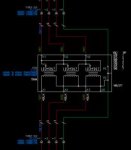emiller233
Senior Member
- Location
- pittsburgh, pa
- Occupation
- Controls-Automation engineer
We have a system that we will need to test to pass a SPE-1000 certification thru Intertek.
This system will operate in Canada or in the USA, so it is designed to run on both: 600VAC, 3-phase as well as 480. There is a 75KVA transformer (Delta to Wye) on the machine to drop the voltage down to 480VAC when in Canada. So if the system is in the USA, they will not use the transformer and wire it to 480.
My question is for the SPE-100 testing we need to run this thing at 600VAC to pass the inspection.
Can we use our shops 480V and run it thru a 480V to 600V step up 75KVA transformer (just for during the inspection)? Would this need to be another delta-WYE transformer? What about the grounding?
i attached a picture of the current transformer wiring (600V to 480V)

This system will operate in Canada or in the USA, so it is designed to run on both: 600VAC, 3-phase as well as 480. There is a 75KVA transformer (Delta to Wye) on the machine to drop the voltage down to 480VAC when in Canada. So if the system is in the USA, they will not use the transformer and wire it to 480.
My question is for the SPE-100 testing we need to run this thing at 600VAC to pass the inspection.
Can we use our shops 480V and run it thru a 480V to 600V step up 75KVA transformer (just for during the inspection)? Would this need to be another delta-WYE transformer? What about the grounding?
i attached a picture of the current transformer wiring (600V to 480V)


